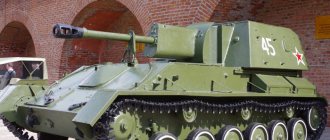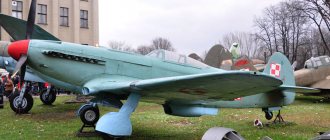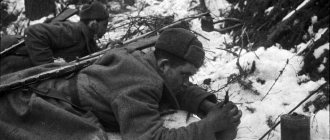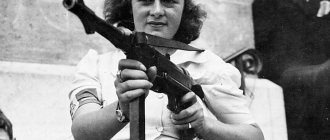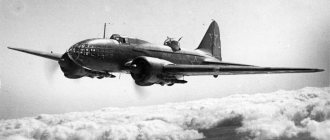German photos from the Great Patriotic War 1941-1943
Quote: Olegich
The Fritz treated our technology with great reverence.
it depends on which one. The Batashki, which made up the bulk of the tank fleet, were obsolete.
Quote: Olegich
It’s just that in 1941 we didn’t know how to fight, we didn’t have intelligence, we didn’t have reliable supplies and communications. Here is the result.
experts in attack! what about correctly determining the direction of the main attack? it's not obvious. It's hard to defend at all. much harder than stepping on it. Read the basics of tactics.
Quote: Olegich
What a huge number of prisoners. Moreover, even in the eyes there is no fear, no hatred, no anger. One curiosity - what's next?
because no one knew what the risk of being captured by the Germans was. people naively believed that the enemy would show humanism and comply with all signed international agreements. and how it turned out - almost 3 million people - the loss of prisoners of war only.
Quote: Olegich
The conclusion suggests itself that the country's military leadership was terribly out of touch with reality.
Indeed? and what? that the country was put on the rails of industrialization? It was only in 1938 that the Red Army was transferred from militia service to normal service. and before that, the country’s leadership had to remove conspirators and careerists from the army (see the “Spring” case).
Quote: Olegich
The technicians were riveted, but the people, warriors, and fighters were not prepared. They drove the peasants away without giving them any knowledge or skills, without providing them with intelligent commanders.
what bad people were in the Kremlin. Wow, an expert from 2012 would have solved and arranged everything in an instant...
Man, the country was poor. I had to decide a lot of things at the same time. We encountered many problems for the first time. Educating millions of people is not a pound of raisins. Before this, enormous efforts were made to solve the problem of agriculture, so that the peasants would not only learn to feed themselves, but also the city. From which box will the required frames magically appear? the people who led the country were exactly the same as yesterday’s lapotniks, only they tried to promote them according to their abilities. The Germans had a soldier with a complete secondary education. Germany underwent industrialization 100 years before Russia. Well, what's the point of rattling your butt now?
Quote: Olegich
It can be seen that the huge columns of our prisoners are guarded by two or three Nazis.
On the filming of German columns of prisoners of war, almost the same thing is visible.
Quote: Olegich
This is the explanation for the enormous losses in the first years and months of the war.
dude, are you even aware of the situation with road transport in the army before the war? There are tanks, but there are no vehicles needed to deliver shells, fuel, and infantry. and cars are needed not only by the army, but also in the national economy. or would you like your grandmother to carry the loads?
on June 22, 1941, it was still not obvious. the war was expected no earlier than the summer of 1942, for which there were objective indicators. you see, ordinary people do not suffer from telepathy and the gift of foresight. This only affects experts who use afterknowledge, but are unable to even plan their own day.
Quote: Olegich
It was enough for the Krauts to bomb, destroy the infrastructure, communications, take in pincers - and that’s it, the morale was broken.
Honor the Germans, smart guy. the bulk of the troops fought to the last, buried themselves in the ground and fought. The Germans first noted that on the Eastern Front the Russians were trying to break out of encirclement, or were forming detachments for war in the German rear. learn the materiel, prosecutor!
Quote: Olegich
At first the Krauts didn’t know what to do with the huge number of prisoners, they just didn’t expect it!!! They found a solution - concentration camps and ovens.
For some reason, ours had the conscience to feed and observe all the required rules in relation to millions of German prisoners of war, although the Soviet leadership had its own complaints about international agreements in this matter. so no need for dirt, son.
German anti-tank artillery in World War II. Part 1
Contrary to popular belief, formed by feature films, literature and computer games like World of Tanks, the main enemy of Soviet tanks on the battlefield was not enemy tanks, but anti-tank artillery.
Tank duels, of course, happened regularly, but not so often. Large oncoming tank battles can generally be counted on one hand.
After the war, ABTU conducted a study on the reasons for the defeat of our tanks.
Anti-tank artillery accounted for about 60% (with tank destroyers and anti-aircraft guns), 20% was lost in battles with tanks, the rest of the artillery destroyed 5%, 5% was blown up by mines, and aviation and anti-tank infantry weapons accounted for 10%.
The numbers are, of course, highly rounded, since it is impossible to determine exactly how each tank was destroyed. The tanks on the battlefield were fired upon by everything that could shoot. Thus, during the battles near Kursk, the destruction of the heavy tank self-propelled gun “Elephant” was recorded by a direct hit from a 203-mm projectile. A coincidence, of course, but a very significant coincidence.
37 mm Pak anti-tank gun. The 35/36 was the main anti-tank weapon with which Germany entered the war.
The development of this weapon, bypassing the restrictions imposed by the Treaty of Versailles, was completed in 1928. The first samples of the gun, which received the name Tak 28 (Tankabwehrkanone, i.e. anti-tank gun - the word Panzer came into use later) entered testing in 1930, and in 1932 deliveries to the troops began. The Reichswehr received a total of 264 of these guns. The Tak 28 gun had a 45-caliber barrel with a horizontal wedge breech, which ensured a fairly high rate of fire - up to 20 rounds/min. The carriage with sliding tubular frames provided a large horizontal aiming angle - 60°, but the chassis with wooden wheels was designed only for horse traction.
By the end of the 20s, this weapon was perhaps the best in its class, far ahead of developments in other countries. It was supplied to Turkey, Holland, Spain, Italy, Japan, Greece, Estonia, the USSR and even Abyssinia. 12 such guns were supplied to the USSR, and another 499 were manufactured under license in 1931-32. The gun was adopted as a “37 mm anti-tank gun mod. 1930." The famous Soviet “forty-five” - a cannon of the 1932 model - traces its ancestry precisely to the Tak 29. But the German military was not satisfied with the cannon due to its too low mobility. Therefore, in 1934, it was modernized, receiving wheels with pneumatic tires that could be towed by a car, an improved carriage and an improved sight. Under the designation 3.7 cm Pak 35/36 (Panzerabwehrkanone 35/36), the gun entered service with the Wehrmacht as the main anti-tank weapon.
The horizontal firing sector of the gun was 60°, the maximum barrel elevation angle was 25°. The presence of an automatic closing mechanism for the wedge-type bolt ensured a rate of fire of 12-15 rounds per minute. An optical sight was used to aim the gun.
The shooting was carried out with unitary shots: fragmentation and armor-piercing. The 37-mm armor-piercing projectile of this gun penetrated 34 mm thick armor at a distance of 100 m. The 1940 model sub-caliber projectile had armor penetration at this distance of 50 mm, and in addition, a special over-caliber cumulative ammunition with armor penetration of 180 mm, with a maximum firing range of 300 m, was developed for the Pak.35/36 cannon. In total, about 16 thousand Pak guns were built. 35/36.
Pak.35/36 guns were in service with anti-tank companies of infantry regiments and tank destroyer battalions in infantry divisions. In total, the infantry division had 75 37-mm anti-tank guns.
In addition to the towed version, the Pak 35/36 was standardly installed on Sd armored personnel carriers. Kfz. 250/10 and Sd. Kfz. 251/10 - command vehicles, reconnaissance and motorized infantry units.
The troops also used various types of improvised self-propelled guns with such guns - on the chassis of Krupp trucks, captured French Renault UE wedges, British Universal armored personnel carriers and Soviet Komsomolets semi-armored tracked tractors.
The gun received its baptism of fire in Spain, where it demonstrated high efficiency, and was then successfully used during the Polish campaign against weakly armored wedges and light tanks.
However, it turned out to be ineffective against new French, British and especially Soviet tanks with shell-resistant armor. German soldiers nicknamed the Pak 35/36 “door knocker” or “cracker” due to its low efficiency.
As of September 1, 1939, the Wehrmacht had 11,250 Pak 35/36 cannons; by June 22, 1941, this number increased to a record 15,515 units, but subsequently steadily decreased. By March 1, 1945, the Wehrmacht and SS troops still had 216 Rak 35/36 guns, and 670 of these guns were stored in warehouses. Most infantry divisions switched to more powerful guns in 1943, but in the parachute and mountain divisions they remained until 1944, and in the occupation units and second-line formations (training, reserve) until the end of the war.
The Wehrmacht also used the 3.7 cm Pak 38(t) , a 37-mm anti-tank gun produced by the Czech company Skoda. At a distance of 100 m, the sub-caliber projectile had a normal armor penetration of 64 mm.
The gun was produced by Skoda by order of the German army, in 1939-1940, a total of 513 guns were produced.
In 1941, Beilerer & Kunz developed the 4.2 cm PaK 41 , an anti-tank gun with a conical bore.
It was generally similar to the Pak 36 anti-tank gun, but had a higher muzzle velocity and armor penetration.
The diameter of the bore varied from 42 mm at the breech to 28 mm at the muzzle. A projectile with crushable leading belts weighing 336 g pierced armor 87 mm thick from a distance of 500 m at a right angle.
The gun was produced in small quantities in 1941-1942. The reasons for the cessation of production were the shortage of tungsten, which was scarce in Germany, from which the projectile core was made, the complexity and high cost of production, as well as the low survivability of the barrel. A total of 313 guns were fired.
The most effective of the captured light anti-tank guns turned out to be the 47-mm Czechoslovakian gun model 1936, which the Germans called 4.7-cm Pak36(t) .
A characteristic feature of the gun was the muzzle brake. The shutter is semi-automatic, the recoil brake is hydraulic, the knurl is spring-loaded. The gun had a somewhat unusual design for that time; for transportation, the barrel was rotated 180 degrees. and attached to the frames. For more compact installation, both frames could be folded. The cannon's wheel travel is sprung; the wheels are metal with rubber tires.
In 1939, 200 units of 4.7 cm Pak36(t) were manufactured in Czechoslovakia, and in 1940, another 73, after which production began on a modification of the gun model 1936, the 4.7 cm Pak (t) (Kzg .), and for self-propelled units - 4.7 cm Pak (t) (Sf.). Production continued until 1943. Mass production of ammunition for 4.7 cm Czechoslovak anti-tank guns was also established.
The ammunition of the 4.7-cm Pak36(t) gun included Czech-made fragmentation and armor-piercing shells, and in 1941. The German sub-caliber projectile model 40 was adopted for service.
The caliber armor-piercing projectile had an initial speed of 775 m/s and an effective firing range of 1.5 km. Normally, the projectile penetrated 75 mm armor at a distance of 50 meters, 60 mm at a distance of 100 meters, and 40 mm armor at a distance of 500 meters.
The sub-caliber projectile had an initial speed of 1080 m/s and an effective firing range of up to 500 meters. Normally, at a distance of 500 meters, it penetrated 55 mm armor.
In addition to the Czech ones, the German army actively used guns captured in other countries.
By the time Austria joined the Reich, the Austrian army had 357 units of the 47-mm M.35/36 anti-tank gun created (in a number of documents this gun was called an infantry gun). In Germany it was called 4.7 cm Pak 35/36(o) .
There were 330 units in service with the Austrian army and went to the Germans as a result of the Anschluss. By order of the German army in 1940, another 150 units were produced. They entered service with anti-tank companies of infantry division regiments instead of 50-mm guns. The gun did not have very high characteristics, with an initial speed of an armor-piercing projectile of -630 m/s, armor penetration at a distance of 500 m was 43 mm.
In 1940 In France, a larger number of 47-mm anti-tank guns model 1937 were captured. Schneider systems. The Germans gave them the name 4.7cm Pak 181(f) .
In total, the Germans used 823 French 47 mm anti-tank guns. The gun barrel is a monoblock. The shutter is a semi-automatic vertical wedge. The gun had a sprung ride and metal wheels with rubber tires. The Germans introduced German armor-piercing sub-caliber projectiles model 40 into the ammunition load of the guns sent to the Eastern Front.
The ammunition of the 4.7-cm Pak181(f) gun included a French armor-piercing solid projectile with a ballistic tip; at a distance of 400 meters, the normal caliber projectile penetrated 40 mm armor.
The anti-tank 5 cm Pak 38 was created in 1938. However, due to a number of technical and organizational difficulties, the first two guns entered service only at the beginning of 1940. Large-scale production began only at the end of 1940. A total of 9,568 guns were produced.
50-mm anti-tank guns, together with 37-mm cannons, were part of the anti-tank companies of infantry regiments. An armor-piercing projectile with an initial speed of 823 m/s, at a distance of 500 meters, penetrated 70 mm of armor at a right angle, and a sub-caliber projectile at the same distance penetrated 100 mm of armor. These guns could already fight the T-34 and KV quite effectively, but from 1943 they began to be replaced by more powerful 75 mm guns.
In 1936, she began designing a 7.5 cm anti-tank gun, called the 7.5 cm Pak 40 . However, the Wehrmacht received its first 15 guns only in February 1942. The gun's ammunition included both caliber armor-piercing shells and sub-caliber and cumulative shells.
It was a very effective weapon, in production until the end of the war, and it turned out to be the most numerous. A total of 23,303 guns were produced.
An armor-piercing projectile with an initial speed of 792 m/s had normal armor penetration at a distance of 1000 meters of 82 mm. Sub-caliber with a speed of 933 m/s, penetrated 126 mm of armor from 100 meters. Cumulative from any distance, at an angle of 60 degrees - armor plate 60 mm thick. The gun was widely used for installation on the chassis of tanks and armored tractors. On March 1, 1945 5,228 units of 7.5 cm Pak 40 guns remained in service, of which 4,695 were on wheeled carriages.
In 1944 an attempt was made to create a lighter 7.5 cm anti-tank gun, called the 7.5 cm Pak 50 . To create it, they took the barrel of a 7.5 cm Pak 40 cannon and shortened it by 16 calibers. The muzzle brake was replaced by a more powerful three-chamber one. All the shells from the Pak 40 remained in the ammunition load, but the length of the cartridge case and the charge were reduced. As a result, a projectile weighing 6.71 kg had an initial speed of about 600 m/s. The reduction in barrel weight and recoil force made it possible to use a carriage from the 5 cm Pak 38. However, the weight of the gun did not decrease much and did not justify the deterioration in ballistics and armor penetration. As a result, the release of the 7.5 cm Pak 50 was limited to a small series.
During the Polish and French campaign, the Germans captured several hundred 75-mm divisional guns model 1897. The Poles purchased these guns from France in the early 20s. In France alone, the Germans captured 5.5 million rounds for these guns. Initially, the Germans used them in their original form, giving the Polish gun the name 7.5 cm FK97(p) , and the French one 7.5 cm FK231 (f) . These guns were sent to the “second line” divisions, as well as to the coastal defenses of Norway and France.
Use guns model 1897. for combating tanks in its original form it was not possible due to the small pointing angle (6 degrees) allowed by the single-beam carriage. The lack of suspension did not allow transportation at a speed of more than 10-12 km/h even on a good highway. However, German designers found a way out: the swinging part of a 75-mm French gun mod. 1987 was superimposed on the carriage of the German 5 cm Pak 38 anti-tank gun. This is how the 7.5 cm Pak 97/38 .
The cannon's valve breech ensured a relatively high rate of fire - up to 14 rounds per minute. The Germans introduced their caliber armor-piercing projectile and three types of cumulative projectiles into the cannon's ammunition; only French high-explosive fragmentation projectiles were used.
An armor-piercing projectile with an initial flight speed of 570 m/s, normal, at a distance of 1000 meters penetrated -58 mm of armor, cumulative, at an angle of 60 degrees - 60 mm of armor.
In 1942 The Wehrmacht received 2854 units of 7.5 cm Pak 97/38 cannons, and the next year another 858. In 1942. The Germans produced a small number of anti-tank installations by placing the rotating part of the 7.5 cm Pak 97/40 on the chassis of a captured Soviet T-26 tank.
Wehrmacht officer training system
Home » Real story » History of Wars » Wehrmacht officer training system
History of WarBooks on the history of the Second World War
Ansar02 06.11.2013 2046
1
in Favoritesin Favoritesfrom Favorites 0
This is an excerpt from the book by Yu. Veremeev “Die Wehrmacht (Wehrmacht) 1935-1945”.
I hope someone finds it interesting (especially in light of the construction of various alternative Red Army).
The German Wehrmacht had a unique officer training system, which guaranteed that the troops were staffed with high-quality officers. A roughly similar system exists today in the Bundeswehr.
Anyone who wanted to become an officer, after checking his trustworthiness through the Gestapo, passing physical training exams through the Jungfolk and Hitler Youth, took the entrance exams to the school.
Then the candidate was sent to a combat regiment (during war, necessarily to the regiment leading combat operations) for a year as a soldier (during war, the period was reduced).
After the end of the term, subject to positive feedback from the regiment command, the candidate received the rank of “fanejunker” equal to the rank of “corporal” and after short theoretical studies (from 2 to 6 months) he was again sent to another combat regiment for a corporal position for a period of 4 to 6 months. During this period, he should have been given the opportunity to perform the duties of a squad commander part of the time. Fanenjunkers who did not meet the requirements of the command did not return to the school, but remained to serve in the unit as corporals.
Upon returning to the school, the Fanenjunker received the title of “Fahenjunkerunterofficer”, took a 2-6 month course of theoretical training and was sent to the third combat regiment as a squad commander. Part of the time he had to serve as deputy platoon commander and company sergeant major.
Subject to a positive response from the command, upon returning to the school, he received the rank of “Fenrich” and, after a short theoretical course, was sent to the fourth combat unit as a platoon commander (for an officer position) and after a specified period of service as a platoon commander at the school, he passed the final exams.
After that, with the rank of “Oberfenrich” he was sent to the regiment for permanent service. The assignment of the rank of “lieutnant” depended on the command of the regiment and division. Basically, the time from admission to the school to the assignment of an officer rank was more than three years (even during the war, and to ensure sufficient replenishment of the troops with officers, enrollment in the schools increased). To be awarded each successive officer rank, it was necessary to undergo 4-6 months of training at the appropriate school or academy for the position to which it was planned to send the officer, and to undergo an internship in a new position.
Thus, there was a constant filtering of quality candidates from random and unfit to lead soldiers. By the time he received the officer rank, the candidate had combat experience and theoretical knowledge; knew how to use all types of weapons, knew how to command soldiers, knew the features of managing various units, and had authority. Internships in various units with different commanders and their decisive conclusion on the suitability of the candidate guaranteed that unworthy people would not receive the officer rank (due to connections, for father’s merits, for origin, etc.). Moreover, in peacetime, no more than 75% of the number of persons who passed the previous stage could be accepted for each subsequent level of training.
A significant part of the officers in wartime were recruited from among distinguished, capable non-commissioned officers. If necessary, they were given the opportunity to receive military education, and before being awarded the rank of officer, they also underwent a course of theoretical training.
With all the hostility towards the fascists, it is impossible not to note that the German officers were above all praise, which Marshal G.K. Zhukov noted in his memoirs.
The officers knew the soldiers, were close to them, knew how to organize a battle, conduct it stubbornly, unconventionally, with initiative; rushed to victory, trying to save the soldiers. They were not afraid to deviate from the charter in order to achieve success. The soldiers trusted their officers, knowing that each of them had been in a soldier's shoes at one time; they willingly followed them into battle, saw them as their more experienced and senior comrades, and protected them in battle.
Our Victory in the war of 1941-45 over the Wehrmacht, led by such high-class officers, only brings honor to our army.
It’s just a pity that this cruel lesson remained unlearned; so no one here understood that the money, time, and resources spent on training officers in peacetime would save a lot of soldiers’ lives during the war. Our current leaders of the country have not learned this lesson, and we are again learning to fight during the war, paying for our studies with the blood of incompetent soldiers and untrained officers.
And the Germans in post-war Germany (and after the 1st and 2nd World Wars) carefully preserved their non-commissioned officers and officers, found the opportunity to allocate money from a meager budget for pensions for former military personnel, for their secret training and retraining (including including in the USSR), and when necessary, they were able to deploy a first-class army in the shortest possible time.
It is only amateurs from military science who can believe that it is enough to hang on the shoulder straps and the general is ready. Military science, the centuries-long experience of all countries clearly says that an ordinary soldier of average (average!) quality can be trained in two to three years, a company commander in 8-12 years. It takes another two years to put together such soldiers and officers into a combat-ready regiment.
And generals are a piece of goods. More talent is required from a general than from an artist. If an artist’s price for mediocrity is whistles in the hall, then the price for a general’s mediocrity is thousands of ruined lives. After all, the art of war is the ability to make the only correct decision in conditions of a lack or even complete absence of information and an acute shortage of time. Intuition is required here more than in a chess game. Try to win a chess game with your back to the board and not knowing how your opponent's pieces are positioned. And this is the general’s job. Any graduate of the journalism faculty can kick the general for failure, defeat, and blood shed in vain. “Everyone thinks of himself as a strategist, seeing the battle from the outside,” says an old Greek proverb. But no one here wants to understand the value of a talented officer or general, to save them, to give them the opportunity to develop their talents without war.
Color photographs of German soldiers and officers in the First World War
We present a selection of photographs of German soldiers and officers from the battlefields of the First World War.
44th reserve battalion consisting of a battery of 90mm guns
Soldier of the 101st Saxon Grenadier Regiment, 1914 Mortar squad with carts on the Montdidier-Noyon front line, 1918
Field portrait of a German soldier, 1918 Young Bavarian infantryman
Commanu Angre, France, 1916
Flamethrowers at the disposal of the 5th assault battalion
Untitled portrait of a German cuirassier regiment officer
Transporting the wounded along a slope near the city of Arras, October 1918.
Captured railway guns near Mont-Notre-Dame, 1918
Crossing a mountain river by military skiers of the Alpine Corps, 1915. Air reconnaissance soldier. German infantryman in the destroyed village of Etricourt, France.
German field military airfield
German Red Cross
German soldier captured by Canadians, July 1917
In a trench before a gas attack
The Belgian population repairs a road for the German army, Belgium, 1916
Departure to the front, 1915
Deployment of German troops in the Belgian Liege, 1914
Officer's uniform
Portrait of a soldier Dead soldier, April 2, 1918
Soldier of the 11th Kurhes Sapper Battalion Landsturmmann Leopold Schmalter, Prussian Infantry Regiment of the 15th Infantry Regiment, III. Battalion 11th Company, August 1917 Military medics Otto Frank, a Dutch Jewish businessman of German origin, fought for Germany in World War I, 1917
Unknown German artillery officer, 1917 Ernst Jünger, German writer, thinker and officer
Prussian infantryman from the 93rd Reserve Infantry Regiment, August 1917
Dominicus Müller
German retreat, Echternach, Luxembourg, 1918
Wounded German soldiers after the Battle of Menin Road, September 20, 1917
Military diver
Two Fokker Dr.I aircraft before takeoff, May 1918
German tank A7V, 1918 Germans in captivity
1 of 14
German prisoners, Vimy commune, 1917
German prisoners, Mareuil commune, France, July 1918
German prisoners are being held by Canadian soldiers. August 1917
German captured by the British, 1917
German prisoners, near the commune of Tijolua, August 18, 1918
German prisoners, Marøy commune, 1918
German prisoners
German prisoners, Villers-Bretonneux, 1916
French and British soldiers near a German A7V tank, Villers-Bretonneux, May 1918
Captured French tank Saint-Chamond
